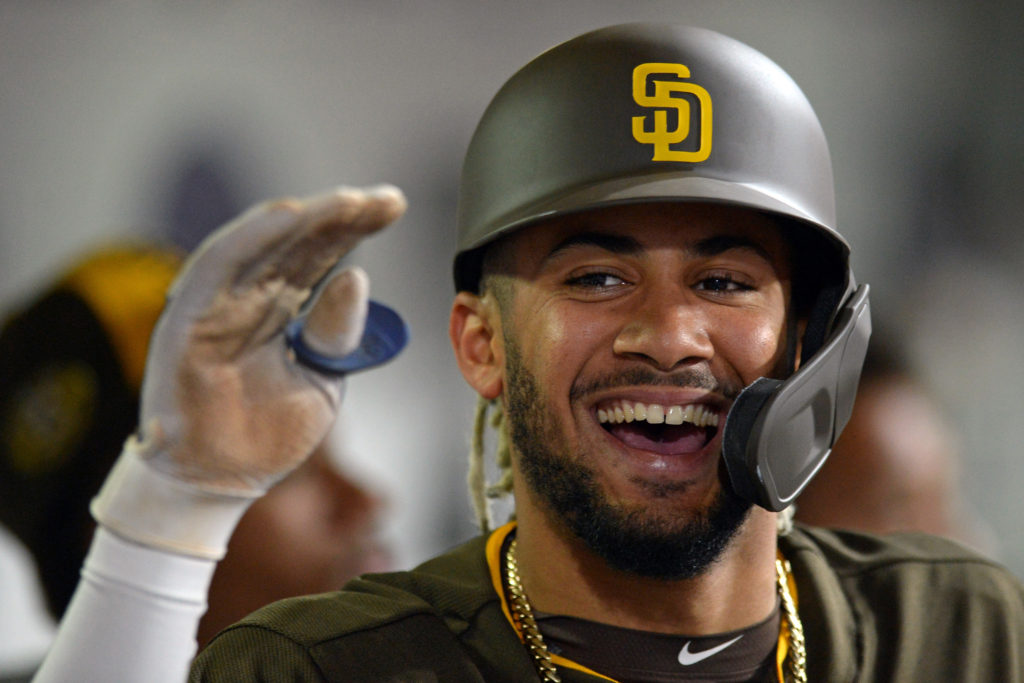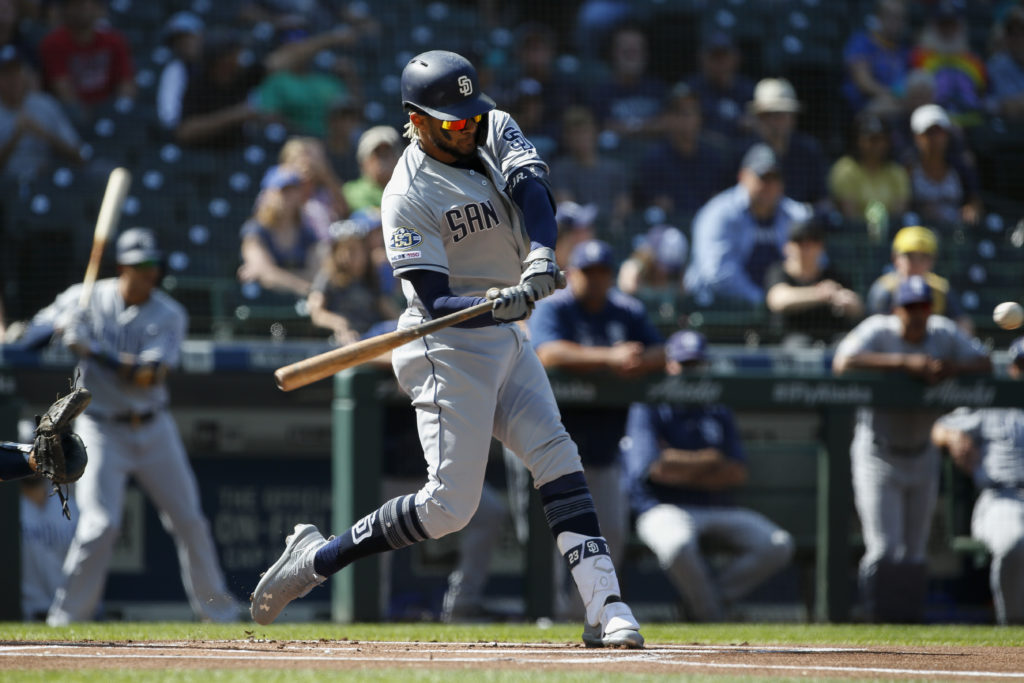What would a Padres’ extension look like for Fernando Tatis Jr.?

Mandatory Credit: Jake Roth-USA TODAY Sports

Should the San Diego Padres explore an extension for Fernando Tatis Jr., and if so, what would it look like?
Some people might be scratching their heads at why there is a discussion about extending Fernando Tatis Jr., a player with just one year of service time and five more years of team control. A trend has started in baseball where teams are offering extensions to players entering their arbitration years, for many reasons.
One is to take the mystery out of the total amount the team will owe a player and avoid arbitration altogether, which can be a hassle for both sides.
Rumor has it the Padres are already exploring this option, according to San Diego Union Tribune’s Kevin Acee.
Arbitration settlements can get messy, especially if the two sides are far apart. It goes to a hearing if the two sides cannot agree on a number, with an impartial arbiter making the final decision. The player and his representatives argue why he should be paid a certain amount. In contrast, the team, right in front of the player, argues why that player is not worth that amount, essentially, insulting the player in an open setting.
That doesn’t happen every time, but some relationships have been strained in the arbitration process. Look no further than former Cleveland Indians pitcher and All-Star, Trevor Bauer, who called the arbitration process with the Indians a “character assassination.” Bauer was dealt to the Reds during that same season.
Tatis will enter his arbitration years following the 2021 season. If Tatis and the Padres want to avoid that mess, they can strike a deal over the next season or two.
A good model for this line of thinking is the situation of Tatis’ fellow young phenom, Ronald Acuña Jr. Acuña and the Atlanta Braves reached an agreement on an extension before the 2019 season, when he was in a similar position as Tatis, with two years before arbitration. Acuña will earn $1 million in 2020, the last of his “team control” years. Then it will jump to $5 million in what would have been his first year of arbitration in 2021.
He will eventually earn $17 million per season as the eight-year deal continues through 2028, totaling in $100 million.
The Braves and their Venezuelan All-Star avoid the awkward arbitration years, the Braves get seemingly a team-friendly deal based on his talents, and Acuña gets financial security with a team that wants him there long term. Plus, knowing what the Braves will pay him for years to come allows the team to make other big decisions with contracts and possible signings, which will only make Atlanta better.
The Royals did the same thing with their All-Star second baseman Whit Merrifield. The year before he hit arbitration, the two sides agreed on a four-year, $16.25 million extension, which again, is an absolute bargain for a perennial .300 hitter.
There is precedent for a deal like what Tatis could get over the next year. There is even precedent for a team extending a young player before they even accrue a year of service time, like Tatis.
The White Sox signed stud prospect Eloy Jimenez to a six-year, $43 million contract before he even saw a pitch in the major leagues. The Phillies locked up their Swiss Army Knife Scott Kingery to a six-year, $24 million before he played a regular-season game in the bigs.
Another reason teams like to lock up players while still under team control is to extend the olive branch of goodwill. It shows the player that the organization cares about them and wants them to be a part of their team for a long time. It’s saying that the team, too, wants to avoid the ugly possibilities of arbitration and that the player is valued more than that trouble is worth.
Something like “goodwill” is hard to measure with stats and analytics. Be that is it may, it’s a lot harder to win and flourish when star players are unhappy with their current situations. The Padres cannot afford to lose Tatis in any way. He is the face of the franchise and has the potential to take his place beside Tony Gwynn and Trevor Hoffman as the faces of the franchise’s history if he fulfills his immense potential.
San Diego should make Tatis feel as comfortable as possible and give him “the keys to the (insert luxury car here).” He has a former big leaguer for a dad who knows the perils of being a major league ballplayer. Thus, Tatis is not wired like some young studs who might get fat and happy once they get their money.
So what would an extension for the Padres’ 21-year-old shortstop look like?
What would be a realistic extension for Fernando Tatis Jr.? (Xander Bogaerts’ deal is 6 yrs/120 mil, for reference)#Padres
— Nick Lee (@NickLee51) February 5, 2020
To hone in more on shortstops specifically, arbitration or not, a deal like the one Xander Bogaerts received might help us. Yes, Bogaerts signed his deal when he was 26 years old, five years older than Tatis, with six previous seasons before the deal, but six years and $120 million looks to be the price of top tier shortstops in their prime.
You can make an argument for both that Tatis deserves more since he is younger and that he shouldn’t get that much, given his lack of major league experience and production over several seasons.
Trevor Story, who MLB Network just named the game’s best shortstop right now, just signed a deal with the Rockies for two years, $27.5 million. This means he will get $9 million this season and $18.5 million in 2021 in what would have been his final two years of arbitration. Much like most comparisons at shortstop, Story is older than Tatis at 27 years old.
| MLB shortstops | 2019 Age | 2019 wRC+ (min 320 PAs) |
| Fernando Tatis, Jr. | 20 | 150 |
| Carlos Correa | 24 | 143 |
| Xander Bogaerts | 26 | 141 |
| Marcus Semien | 28 | 137 |
| Gleyber Torres | 22 | 125 |
| Trevor Story | 26 | 121 |
| Jorge Polanco | 25 | 119 |
| Francisco Lindor | 25 | 114 |
| Javier Baez | 26 | 114 |
| Paul DeJong | 25 | 100 |
Francisco Lindor is a bit younger than Story or Bogaerts and more comparable to Tatis, and he just received $17.5 million for 2020 after arbitration.
Considering the deal Acuña got at such a young age, plus the contracts the comparable shortstops received, Tatis will likely be looking in the $16 million to $19 million range. He does not yet have the accolades and track record of Lindor or Story, but he is also much, much younger. Acuña is an outfielder, but at a similar age to Tatis, and will receive $17 million after two more years. Acuña’s deal may be the best blueprint.
Let’s start with the number of years. Being 21 years old like the Friars’ Dominican shortstop has its advantages. He could sign an eight-year deal and still hit free agency before he turns 30. So let’s give Tatis eight years at the start of this year, meaning he will be a Friar through the 2027 season.
The salary is tricky because the Padres could work up to his full value of perhaps $18-plus million per year but start slow, like the Acuña deal ($6 million total over the first two years, then up to $17 million per season afterward). Tatis’ team controlled-salary this year is just under $600,000.
The Friars would do well to more than triple that salary this season, at $2 million, and work up from there. In 2021, his final year before arbitration, let’s bump it way up to $15.5 million, closer to Acuña and Lindor range. For the 2022 season and the next five years, we will pay him the plateau of the contract amount of $18.5 million, the same that the supposed best shortstop in the game today, Story, is getting.
The total contract adds up to an eight-year, $128.5 million deal.
To make the Padres a bit more comfortable in case something disastrous happens, the last two years can be a club option, like Acuña’s deal.
Tatis has only played 84 games in the big leagues, but there is precedent to offering an extension this early, and both sides can benefit from a deal. He clearly has shown he not only belongs in the big leagues, but he can be a true face of the league donning a Padres uniform, something not done perhaps since Mr. Padre himself.
Native of Escondido, CA. Lived in San Diego area for 20 years. Padres fan since childhood (mid-90s). I have been writing since 2014. I currently live near Seattle, WA and am married to a Seattle sports girl. I wore #19 on my high school baseball team for Tony Gwynn. I am a stats and sports history nerd. I attended BYU on the Idaho campus. I also love Star Wars.
There is a risk to letting him play another year to get a better sense of his durability. However, if he has an all-star year and gets 500AB, the price might rise. That’s still a wise way to handle this.
I could see 8/160 with a couple of club options years at 30M with 2M buyouts thereafter. We could lock him up until after he’s 30. Odds are, those might be very inexpensive years.
The Braves received extremely favorable deals from both Acuna and Albies. (Trout was very team friendly with his contracts). If the Padres could do that, then great. But we are talking about Preller, who not only gave out the worst contract in recent memory, there was zero competition for Hosmer. He even made it for EIGHT years! (This, not to mention other disasters, like Myers.)
On top of this, Tatis is likely an OF, not a SS. Missing a large chunk of the season with a lower back injury from a swing/check swing is alarming. If he were 60 years old, then okay, but he was 20! That, on top of the many other injuries (and questionable defense at SS) points to a need to be in the OF, perhaps CF.
Even more, which contract/extension of Preller’s has worked out? This is not “Preller bashing,” it is reality. Maybe after he is fired the Padres can negotiate with Tatis.
agree. Tatis as CF could prove to be wise choice.
Wait 1 more year…let’s see if Tatis can stay healthy for a full season.